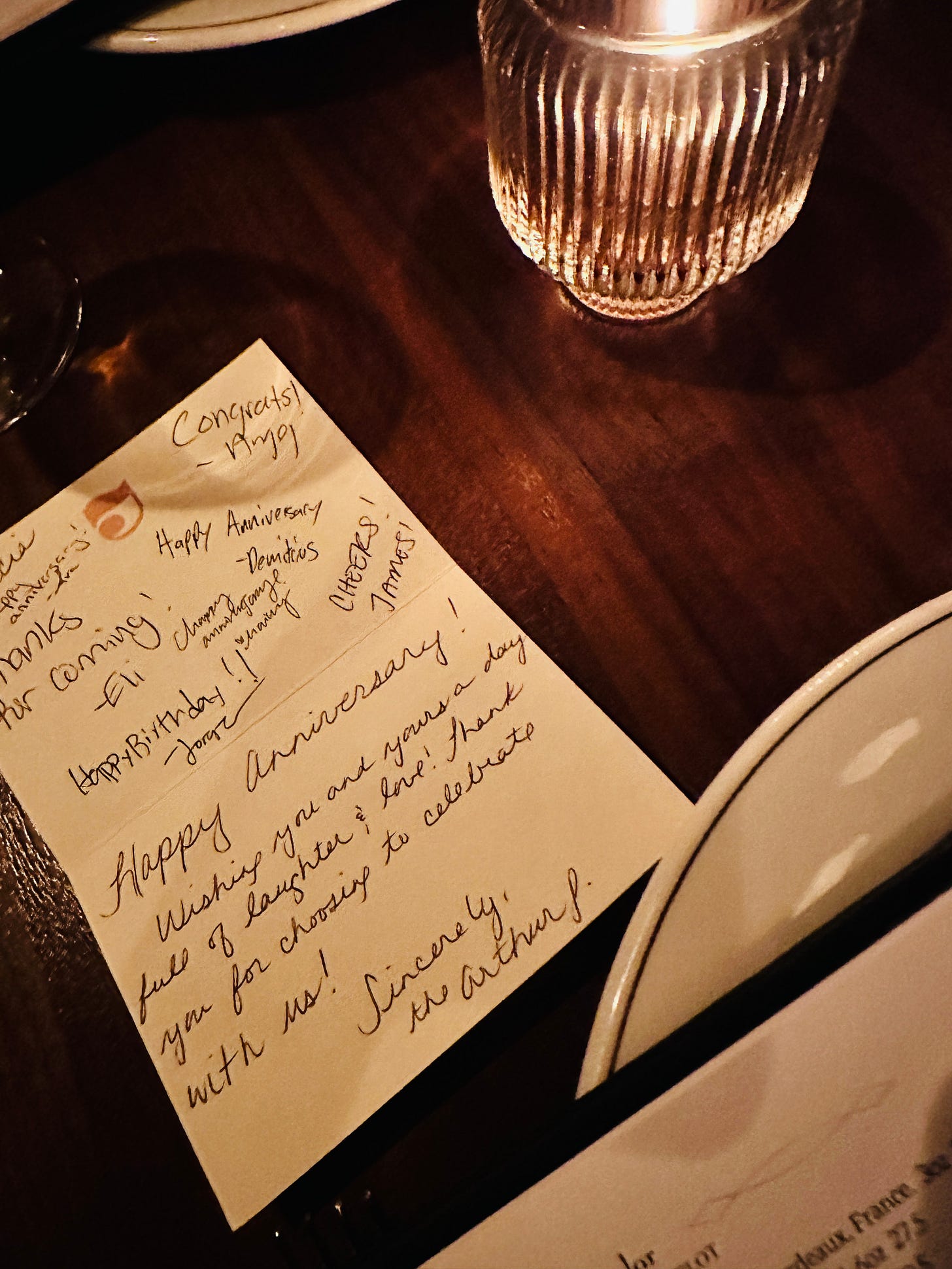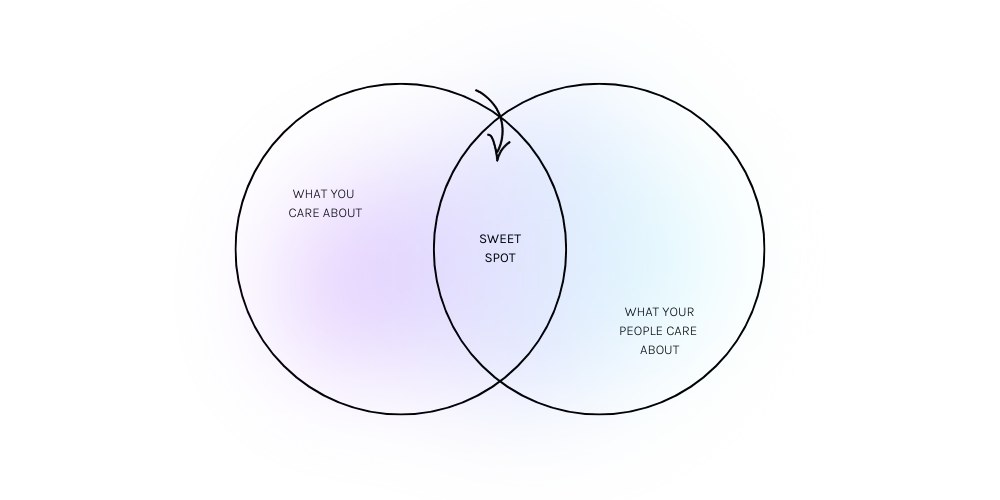Welcome to The Content Brief 💼, your roadmap to showing up consistently (with intention)—delivered in brief, straight to your inbox.
New here? Welcome! Subscribe free.
⏪ Last time, my report on the *incredible* Content Spark Summit. That's here.
⏩ Today, what to listen for and how to track what your people need to hear from you.
I walked through the swanky beachside steakhouse with a little extra pep. It was our anniversary. We had a babysitter. It’s a beautiful restaurant with great ambiance (makes a big difference for me) and killer food. We sat down to a candlelit, handwritten notecard that had been signed by all the staff (seriously A+++ for surprise and delight detail).

And it was all divine until I shifted in my velvet tufted chair and realized just how close our two-person table was to the two-person table next to us.
Uncomfortably close. They could’ve easily been mistaken as being part of our group. I could’ve accidentally picked up her water glass … ok, not that close but almost.
And I hate that.
For one, it feels so weird that they can easily hear everything I’m saying.
But mostly because I cannot help but listen to every word they’re saying.
Call it hazards of the profession or whatever you will, I am totally nosy.
So yes, I want to know how this guy in the faded metal band t-shirt and blazer is going to help this 50-something-going-for-25 lady get her newly self-recorded album picked up by “the label” as he says he is. Every detail, please.
And that is not conducive to carrying on my own anniversary dinner conversation.
So while listening in on people may not be overly helpful while at a swanky steakhouse, it is absolutely helpful in better connecting with your audience.
Allow me to explain.
You’ve no doubt heard me say by now that curiosity is key to building connection and community.
But it’s not our natural response in becoming a “creator.”
So often we reach for success by showing up as an “expert,” the person with all the answers ready to guide others to the transformation.
But providing value doesn’t mean having all the answers.
Instead, it takes a willingness to lead a conversation, inviting us on the journey of an idea and vetting your perspective in real-time via your content.
So what does it actually look like to connect with others online?
What’s even the first step to figuring out what we would connect about?
I probably don’t have to tell you that when it works—when you connect with the right people and what you’re creating resonates to the point that they engage with it—it makes showing up online energizing. People appreciate your work! They want to know more! They thank you for helping them solve a problem!
But without that connection, when what we’re creating is not being received in the way we hoped, it’s really easy to start disliking showing up altogether. And that often leads to inconsistency.
Been there? Me too. 🙋♀️
The good news is it can be changed!
If you are sharing anything online (ie. creating content), you are inviting others to connect with you.
And as it turns out … it takes releasing what we think we’re supposed to talk about and instead sharing what we actually care about.
Ok yes, this is tough to do. With years of j-school training and having directed content marketing efforts for an international nonprofit for so long, I’ve been trained, conditioned even, to leave myself out of it. To focus on the story. To give voice to others.
But in an inbox? It’s personal. You are opening this writing from me—it’s 1:1.
I’ve spent a long time creating in the hopes of connecting, and I think it’s what so many of us do. We create and create and create but it ends up being simply more stuff, more shouting into the void.
But there’s another way.
You can write in the sweet spot between what you care about AND what your ideal reader cares about—and think of it as an ongoing journey of exploring the topic together.
That means any idea you have gets filtered through two questions:
Do I care about this? (Am I excited to share it?)
Do my people care about this? (Is it relevant to them right now?)
It’s in that intersection of what you care about and what your people care about where you get to the good stuff. Then, when you take it a level deeper to tap into how your people think and feel and discover what moves and motivates them, that’s what leads to meaningful connection.
Step 1 is to create a robust list of everything that makes you you—what you do, what you enjoy talking about, what actually shows up in your real life.
The themes you identify and the golden threads you pull on to get to your content sweet spot should be conversations you want to lead—something that’s exciting for you to share and relevant to your people.
Get the starter list of questions to help you identify yours here:
You can then answer those same questions for your ideal reader and do a side-by-side comparison to find the golden threads—but you’ll probably need something a little more, and that’s where this next exercise comes in handy.
Step 2 is to find the overlap and drill down into what your audience is thinking and feeling and cares about.
My favorite tool for this is one copywriters use to better understand (and write to) their ideal person—the empathy map.
It’s one of those living documents to continually add to as you encounter questions, conversations, survey data, reviews and more from your community. You can also add info from those who fit your ideal reader profile in Reddit queries, Amazon reviews, even competitor Instagram comments. (I keep it as a regular-use part of the content system I’ve created.)
Add to your empathy map keeping in mind what your ideal reader is experiencing now:
What is their struggle/problem/pain/challenge? What do they need to solve it?
What are their hesitations? What makes them worry about taking action?
How would their life be better with what you offer? What does success look like?
Then “map” what you find in the quadrants of your empathy map, noting what your reader says, thinks, does, and feels—especially using their words when you can.
Says: What they say, verbatim, in reviews, interviews, and so on—their quotes and specific feedback.
Thinks: What you infer they are thinking throughout the experience based on what they've said. This often includes insights into their motivations, concerns and thoughts that may not be directly expressed.
Does: Their actions and behaviors. What do they do? How do they interact with your product or service?
Feels: Their emotional state along the way. What are their feelings about the experience? Are they frustrated, delighted, confused…?
Just this week, I received this note from a new member of the club 🎉 (shared here with her permission and identifiers removed):
So here’s what I’m adding to my empathy map:
Says: “I’ve had enough of creating content just for the sake of it. I want to build a community and create content I’m proud of which works around my day job and my family life.”
Thinks: How to effectively manage time between work/family/creative pursuits; Wants to create meaningful content that resonates with her audience; Considering strategies to grow her community.
Does: Joined The Content Brief club; shares creative prompts and drawing sessions.
Feels: Frustrated and dissastisfied with current full-time job but has a sense of purpose in wanting to provide value through her creative work; inspired, motivated, determined and ready to take action.
Jot down everything you find or hear. Collect it over time. Look for patterns and insights. What are the common themes? You’ll be amazed at what it all reveals about your ideal reader and what they need to hear from you.
And then you can use their exact language to better explain how you can help—and to create more valuable content.
So start asking questions. Start listening to your community. Start mapping it all.
It’ll make the figuring out what to say part so much easier.
For more:
💌 Subscribe to The Content Brief and get my Content Idea Bank and set-up tutorial free.
🎉 Join the club for help simplifying your content (including access to the Quarterly Content Planning Party!).
📩 Forward this to a creative friend who could use a roadmap to showing up consistently (with intention), too.
Thank you! I pour a lot of love into this space and I hope you can feel it. It wouldn’t be the same without YOU! 🫶








Wow, I had no idea I was given that much of myself away in that one email of introduction. I love how you’ve broken it down into different sections too. Last year I ran the pilot of my creative membership before moving it to Substack this year, at the end of it I asked people for feedback and really never did anything with it. I’m going to go back to them now and break them down the way you did and see what I can read between the lines in terms of what my reader says/thinks/does and feels. Thanks Christin!
Love this framework and the idea of keeping a working document. I have a lot of it in my head, but it ends up in a jumble much of the time!